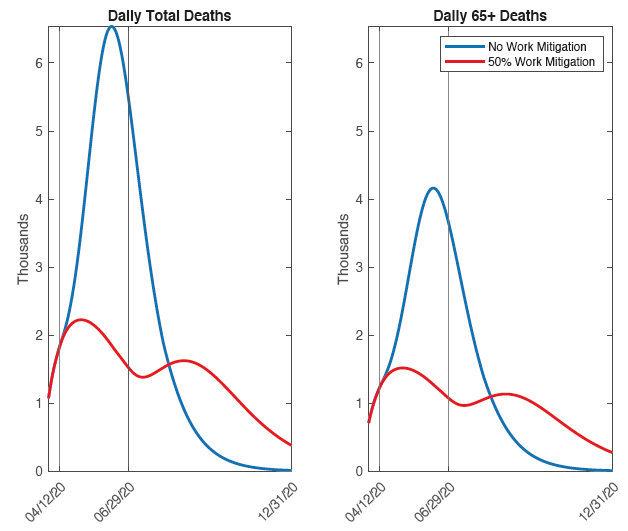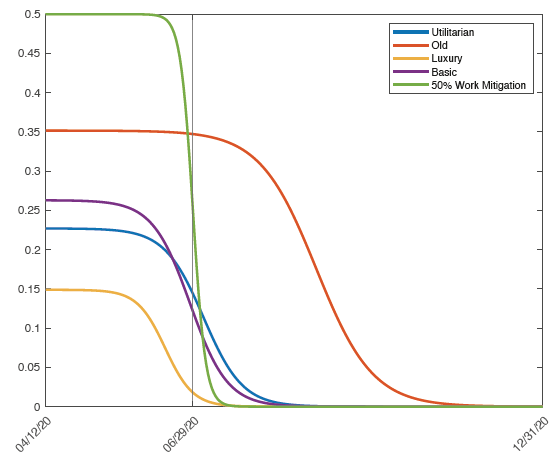Large portions of many countries’ economies have been shuttered to slow the spread of COVID-19. When and how should we end these shutdowns? In the early days, there was broad consensus that a cautious approach was appropriate. But as time has passed, disagreement has become more apparent, with protesters in many US cities pushing to reopen the economy, and many countries in Europe preparing to do so gradually.
Why, three months into the pandemic, does the optimal policy response remain so controversial? In our recent working paper (Glover et al. 2020), we focus on one key dimension to the crisis that is implicit in much of the policy debate, but absent in much of the formal economic analysis. This is the fact that shutdowns have enormous distributional implications, and naturally create big winners and losers.
To start with, the reason countries have imposed shutdowns in the first place is to slow the spread of the virus. If a business is closed, neither employees nor customers can contract the virus at the business’ physical location. Reducing COVID-19 spread potentially benefits everyone who has not yet been infected, but these benefits vary enormously by age. Current best estimates suggest that individuals over the age of 65 are 25 times more likely to die from COVID-19 than those below 65, conditional on infection. Thus, shutdowns, to a first approximation, are designed to protect the old.
On the other hand, the costs of shutdown policies are mostly born by the young, because it is households of working age whose jobs are threatened. Even within this group, the costs are likely to be shared unevenly, and concentrated on workers in sectors deemed ‘non-essential’ and subject to enforced closure or stay-at-home orders.
We seek to quantify the welfare effects of shutdown policies, with a focus on how they vary across different types of households. The recent macroeconomic models that study the trade-off between depressing economic activity and reducing COVID-19 mortality typically assume a representative household structure, in which everyone benefits equally from shutdowns in the form of reduced infection risk, and suffers equally in terms of reduced output and consumption (e.g. Eichenbaum et al. 2020). How do policy prescriptions change when the costs of shutdowns are disproportionately borne by one group (those working in non-essential businesses), while the gains disproportionately accrue to another (the retired)?
The calibrated model we use to quantify trade-offs and to explore alternative policies integrates a workhorse model from epidemiology with a simple macro model. On the health front, our starting point is a Susceptible-Infected-Recovered (SIR) framework, in which susceptible individuals become infected and then recover. On the economic side, aggregate output and consumption are pinned down by total employment, which in turn depends on the share of workers that are healthy enough to work, and on the extent of the shutdown policy.
Our first modelling innovation is to differentiate between young and old. Age matters for two reasons. First, the old face a much worse distribution of health outcomes, conditional on contracting the virus. Second, only the young work, which automatically protects the old from virus transmission in the workplace. The second dimension in which people in our model differ is in terms of the sector in which they work. Workers in sectors deemed essential – e.g. food production and distribution, healthcare, utilities, law and order – are insulated from shutdowns. All unemployment risk is loaded onto workers in what we call the ‘luxury sector’ – think of leisure and hospitality, most of manufacturing, and education.
A crucial part of the model is the specification of how the virus is transmitted, and how that interacts with economic activity and government-mandated shutdowns. We consider four forms of transmission: from co-workers in the workplace, from fellow consumers in market activities, from family members and friends, and from the sick in hospitals. To model this transmission more precisely, we break the infected state into three sub-states: those who are infected but Asymptomatic, those suffering fever and other Flu-like symptoms, and those with serious complications who need Emergency care in hospital. We label this extension a ‘SAFER’ model, reflecting possible progression from Susceptible to Asymptomatic, to Flu, Emergency care, and Recovered. These different subgroups pass the virus on in different ways. The asymptomatic group (which randomised testing suggests might be quite large) are more dangerous than the group with flu, because the latter stay home from work, while the former do not. If we could test everybody, shutdowns would not be necessary: the asymptomatic group could simply be instructed to stay at home. When universal testing is not feasible (it currently isn’t) then shutdowns can be a blunt but effective tool for reducing transmission associated with the workplace and with consumption activities.
In this setting, we consider a government with two policy levers. First, it decides what fraction of the luxury sector to shutter – we label this the extent of mitigation. A corresponding fraction of luxury sector workers is told to stay at home, reducing workplace infection, and reducing luxury sector consumption and thus consumption-related infection. The second policy lever is a choice about redistribution. We allow the government to effectively tax workers in order to make transfers to all the non-working households: the old and retired, those infected with flu or hospitalized, and those unemployed due to the shutdown. A key calibration decision is how costly to make this redistribution. In practice, different countries have implemented an array of different redistributive policies, including expanded work-share programs and unemployment benefits for workers, and grants and subsidized loans for small businesses. But the current or future taxes to finance these policies will distort labour supply and investment decisions, with associated deadweight costs. These costs imply an important two-way interaction between optimal mitigation and optimal redistribution: larger shutdowns necessitate more redistribution, but because additional redistribution is costly, the government’s appetite for mitigation is dampened.
With this machinery in place we pick parameter values. A key choice is the flow value of utility while alive, which determines how much consumption people are willing to sacrifice to reduce the risk of death. Following the Environmental Protection Agency, we use a value of a statistical life of $11.5 million (European agencies use smaller values). Health transition probabilities, in particular those associated with the number of asymptomatic cases, also remain quite uncertain. To determine the parameters that govern the early dynamics of the virus, we ask the model to match some key facts about the evolution of the US death toll from COVID-19 up to 12 April, which is the date at which our model government chooses a mitigation path going forward. We find that the model can replicate the path for deaths if we allow for a sharp decline in infection-generating rates around 21 March. Of this decline, we attribute a portion to the explicit introduction of shutdowns, which many states announced around this date, while the rest is attributed to non-policy-related changes in social distancing behaviour, as fear of contracting the virus rose.
Given our baseline calibration, we first plot the predicted dynamics of the pandemic under alternative economic mitigation scenarios. The red line in Figure 1 plots predicted daily deaths under our approximation to current US policy, in which half of the luxury sector (27% of the entire economy) is shut down for 100 days, beginning on March 21. The second blue line represents a counter-factual scenario in which the shutdown ends at Easter (12 April). Under the baseline policy, daily deaths never exceed 2,500, while under the counterfactual they rise above 6,000. Two thirds of model-implied deaths are accounted for by the old, even though the over-65 age group only constitutes 15% of the total population. In New York City, for comparison, those over 65 account for 72% of reported deaths as of 14 April. Cumulatively, the baseline policy predicts 418,000 total deaths, while ending mitigation at Easter would have been costlier, with 590,000 deaths.
Figure 1 Daily deaths from COVID-19
Notes: Red line = 50% percent of luxury sector shut down until June 29. Blue line = shutdown ends on April 12. Left panel: total deaths. Right panel: deaths among those age 65+.
We then explore which policies different household types in the model prefer, and the size of the associated welfare gains, relative to an ‘end the shutdown at Easter’ scenario. Figure 2 shows the mitigation policies that each type would choose from 12 April onwards, if they got to pick, under our baseline calibration. The first key finding is that the old want extensive and prolonged shutdowns, lasting into the Fall. For that group, a lot is at stake: moving from no shutdown to their preferred one is equivalent to a permanent 1.7% consumption boost. The young, in contrast, are much more ambivalent about shutdowns, especially those working in the luxury sector. They still want a partial shutdown, but would like it to be modest and short. The associated welfare gain, relative to no shutdown at all, is worth less than 0.1% of consumption. A government maximising utilitarian social welfare compromises, picking an intermediate path for mitigation.
Figure 2 Optimal mitigation paths
Notes: Green line = 50% percent of luxury sector shut down until June 29. Red, purple and yellow lines = policies preferred by the old, by basic sector workers, and by luxury sector workers. Blue = policy chosen by utilitarian government.
We conclude that current disagreements over when to end shutdowns are easy to understand. Our model predicts that some groups – young workers in sectors deemed non-essential – would benefit from ending the current shutdown, while others – the old – will surely lose. Redistribution can render the welfare impacts less unequal, but only up to a point. These inequality concerns make it all the more urgent to rapidly develop alternatives to shutdowns for slowing virus diffusion, such as testing and tracing programmes.
Authors’ note: The views expressed herein are those of the authors and not necessarily those of the Federal Reserve Banks of Minneapolis or Kansas City, or the Federal Reserve System.
References
Atkeson, A (2020), “What Will Be the Economic Impact of COVID-19 in the US? Rough Estimates of Disease Scenarios,” NBER Working Paper 26867.
Eichenbaum, M, S Rebelo, and M Trabandt (2020), “The Macroeconomics of Epidemics,” CEPR Discussion Paper 14520.
Glover, A, J Heathcote, D Krueger and J-V Rios-Rull (2020), “Health versus Wealth: On the Distributional Effects of Controlling a Pandemic”, CEPR Discussion Paper 14606.
Toxvaerd, F (2020), “Equilibrium Social Distancing,” Cambridge-INET Working Paper Series No: 2020/08.
Endnotes
1 Atkeson (2020) was the first to apply this framework to COVID-19. For earlier economic applications see, for example, Toxvaerd (2020).









